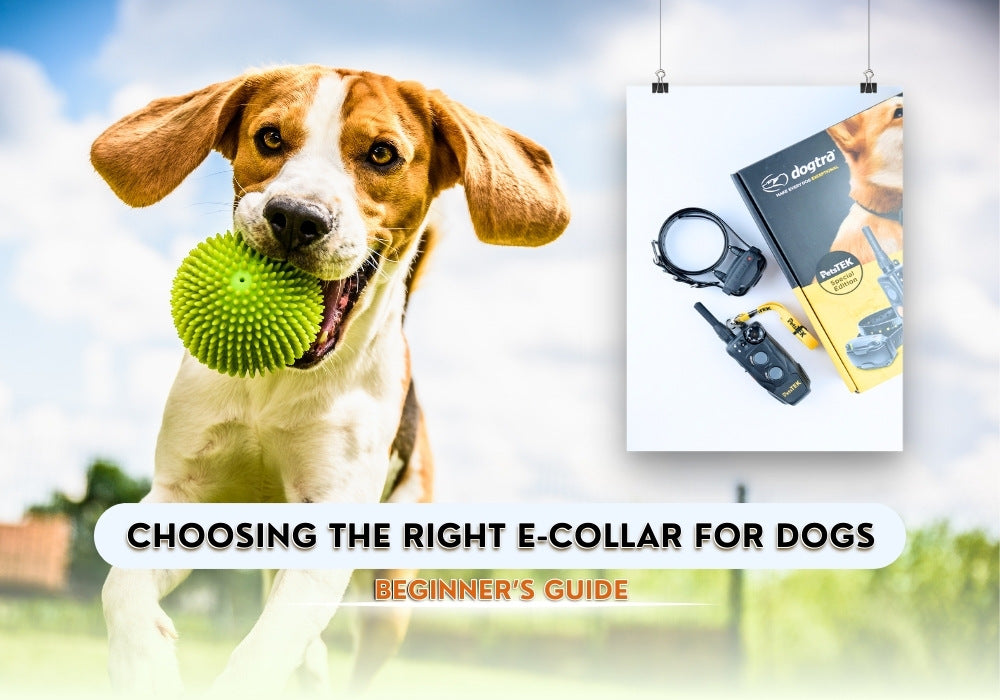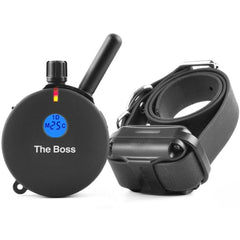Beginner’s Guide to Choosing the Right E-Collar for Dogs

This article was updated on February 26, 2024.
Training your dog is a journey that comes with its fair share of rewards and challenges. While positive reinforcement is the go-to method for many, e-collars can be an effective tool in certain training scenarios. But choosing the right e-collar is critical – not only for your dog’s safety but also for your training results.
This guide will walk you through the essential factors you need to consider when picking an e-collar for your dog. Whether you’re a beginner or just upgrading your gear, these tips will help you make an informed choice that suits your dog’s needs.
For those short on time, feel free to skip ahead to our section on how to choose the right remote training collar for your dog. Otherwise, take a moment to gain insights about e collars for dogs and why selecting the right one is essential for effective dog training.
Table of Contents
[Hide]- What Is an E Collar?
- How Does a Remote Training Collar Work?
- When Can You Start Using an E-Collar for Your Dog?
- Why Choosing the Right E-Collar Matters
- The Criteria - Choosing the Right Remote Training Collar as a Beginner
- Making a Choice
- Best E Collar for Dogs
- How Do You Use an E-Collar Effectively
- Final Thoughts
- Frequently Asked Questions About E-Collars
What Is an E Collar?
An e-collar, short for electronic collar, is a dog training device that uses electronic signals to communicate with your dog. It typically consists of a handheld transmitter and the e-collar worn around your dog's neck.
E-collars for dogs go by various names, such as remote training collars, dog training collars, or remote trainers. So, if you notice any of those terms in this e-collar guide, just know they all refer to the same thing.
How Does a Remote Training Collar Work?
One of the key benefits of using an e-collar is the clear communication it provides between you and your dog. Here’s a step-by-step breakdown of how an e-collar functions:
- Signal Transmission: When you press a button on the remote transmitter, it sends a radio signal to the receiver collar around your dog’s neck.
- Signal Reception: The receiver collar, equipped with contact points or prongs, picks up the signal sent by the transmitter.
- Stimulation Delivery: Based on the type of correction selected — such as a beep, vibration, or static stimulation — the receiver collar activates. The chosen stimulation is delivered through the contact points, which rest against your dog’s skin. This provides feedback, prompting your dog to respond to the command or adjust their behavior.
For example, if your dog is ignoring a recall command, you can send a gentle vibration to get their attention. More advanced e collars allow for adjustable intensity levels, ensuring that the correction is appropriate for the dog's temperament. Over time, this helps reinforce commands and correct unwanted behaviors.
When Can You Start Using an E-Collar for Your Dog?
The general guideline is to begin using an e-collar when your puppy is around 6 months old. By this age, they are usually mature enough to understand the corrections. It's crucial to remember that an e-collar should only be introduced after your dog has mastered basic commands.
If you're new to e-collars, it’s best to consult with a dog trainer to make sure you navigate the process correctly.
Why Choosing the Right E-Collar Matters
Selecting the best e collar for dogs is crucial for effective and humane training. E collars for dogs vary widely in features, depending on the brand and model. Hence, finding one that suits your dog’s specific needs is the first step toward training success.
Furthermore, different remote training collars offer various levels of stimulation, range, and additional features like tone or vibration modes. Some are designed for small breeds, while others are better suited for larger or more stubborn dogs.

The Criteria - Choosing the Right Remote Training Collar as a Beginner
What should you look for when buying an e-collar? To make an informed decision, consider the following tips when selecting your first remote training collar:
1. Consider where you plan to take your dog and how far they will need to go off-leash.

The effective range between the transmitter and receiver collar is a crucial factor in your selection. It determines how far your dog can roam while still being under your control. The standard range for e-collars is about ½ mile, which is typically sufficient for basic obedience training and off-leash play around your property.
Keep in mind that terrain and canopy cover can impact the actual effective range of the e-collar. Manufacturers usually specify the range based on a clear, unobstructed line of sight. Therefore, if you plan to take your dog to the countryside or open fields, consider choosing an e-collar with a longer range.
2. Discover your dog’s sensitivity before buying an e-collar.

Observe your dog's sensitivity to physical stimuli during heightened situations. For instance, if your dog chases a rat through thorny shrubs without hesitation, it suggests that they have a low sensitivity to physical stimuli when they're highly aroused.
Understanding your dog's sensitivity will help you select an appropriate e-collar — whether you need low to medium or higher power output. Stubborn dogs or those with low sensitivity may require higher stimulation compared to highly sensitive ones. This is especially crucial in life-threatening situations, such as when your dog escapes and risks running into a busy street. Sending the correct feedback through an e-collar can prevent your dog from endangering themselves. In such scenarios, having the right dog e collar is essential.
3. Choose an e collar that is safe and humane for your dog.

Source: BritishDog.net
Remote dog training collars are training tools, not punishment devices. Modern collars emit static stimulation that does not harm your dog. Choose a collar with adjustable stimulation levels of at least 100 intensity levels. Good e-collars also offer alternative forms of stimulation, such as vibration or tone, in addition to static. Alternative stimulation is suitable for shy and sensitive dogs that respond quickly to vibration.
Additionally, some shock collars come with a lock switch or safety feature to prevent prolonged correction. Most training collars are designed to deliver stimulation for a limited time, typically up to 10-12 seconds. Even if you forget to release the button after 12 seconds, the stimulation automatically stops as a safety feature. A lock switch allows you to set the stimulation level and prevent sudden jumps to higher levels, avoiding overstimulation of your dog.
4. Pick a remote trainer that fits your dog’s breed and size.

A dog shock collar won’t work effectively if the collar is not the right fit for your dog. If the collar hangs loosely around your dog's neck, the stimulation may be delivered inconsistently, potentially confusing your dog about what you want them to do. On the other hand, a collar that is too tight can cause skin irritation and pose a choking risk.
Additionally, if you have a Siberian Husky or a dog with a thicker coat, check the prongs of the receiver collar. It is better to choose e-collars with longer contact points to ensure that the correction is transmitted effectively.
5. Consider buying a fully waterproof e-collar.

Think about whether you’ll need to take your dog near bodies of water or if you plan to install a pool on your property. While most receiver collars are now waterproof, some transmitters are not.
Even if you don’t anticipate taking your dog swimming, it’s wise to prepare for unexpected situations, such as getting caught in the rain during outdoor training.
6. Check the batteries of the remote training e-collar.

Rechargeable units are generally preferable to e-collars powered by replaceable batteries, as they save you money in the long run. A quick-charge battery is also a plus for managing downtime.
However, if you enjoy traveling or have camping plans with your dog, an e-collar that uses replacement batteries can be very handy.
7. Look for the expandability of the shock collar.
Some remote training collars can be expanded to accommodate 2-3 dogs, or even more. These e-collars allow you to pair additional collars with a single transmitter. If you have multiple dogs that need training, consider the expandability of the e-collar. This feature helps you save costs and simplifies control, as you won't need to carry multiple transmitters while training several dogs.
8. Inspect the warranty and manufacturer of the dog collar.




Reputable brands offer long warranty periods because they have confidence in the quality of their products. Industry-leading brands, such as Dogtra, E-Collar Technologies, SportDOG, and PetSafe, produce e-collars designed to last for many years, ensuring reliable performance.
Making a Choice
After knowing the factors to look for an e-collar, you can narrow down your choices to find the best e collar for your dog.
Key Takeaways
- Contemplate how much range you will need.
- Discover your dog’s sensitivity.
- Choose a dog collar that is safe to use.
- Take into account your dog’s breed and size.
- Opt for a fully waterproof e-collar.
- Consider an e-collar with rechargeable batteries.
- Check for the collar’s expandability.
- Inspect the warranty and reputation of the brand.
Best E Collar for Dogs
If you’re ready to make your first purchase, PetsTEK has a few recommendations to help you out:
Best Over-All: ET-300 Mini Educator by E-Collar Technologies

The ET-300 Mini Educator e collar tops our list of the best e-collars for your dog. This collar has a ½-mile range and 100 levels of static stimulation. It also comes with a tone and vibration ideal for sensitive or deaf dogs. An excellent choice for dogs 8 pounds and larger, this dog training collar is fully waterproof and rechargeable. Other than yellow, it’s also available in black and Educator Zen 300 variants.
Best for Small Dogs: ME-300 Micro Educator by E-Collar Technologies

The ME-300 Micro Educator is a training collar designed for the smallest dogs. It’s smaller, lighter, and has 20% less stimulation than the Mini Educator dog collar. It comes with four correction modes: nick, constant, Pavlonian tone, and non-stimulating vibration. Ideal for dogs as small as 5 pounds, this ecollar allows training for up to ⅓-mile range. It’s a fully waterproof remote trainer, which is expandable for up to 2 dogs.
Best for Medium Dogs: Dogtra 200NCPT PetsTEK Edition

The Dogtra 200NCPT is a dog shock collar great for small to medium dogs. This has a ½-mile range, 100 static stimulation levels, an audible tone, and an HPP vibration. Best for dogs 12 pounds and up, it’s a training tool designed for obedience training and off-leash walks.
Best for Large Dogs: Boss Educator ET-800 by E-Collar Technologies

The Boss Educator ET-800 is created for large, stubborn dogs. It has a 1-mile range, 100 levels of static, and an additional boost of up to 60 levels. While it may be excellent for stubborn breeds, this Educator dog collar also comes with tone and vibration. It’s fully waterproof, rechargeable, and recommended for dogs 20 pounds and larger.
Best for Hunting Dogs: SportDOG SD-425X FieldTrainer E-Collar

SportDOG is a popular brand for hunting dog collars. Built for field training and hunting, the SD-425X FieldTrainer is the smallest and lightest shock collar yet by SportDOG. It has a 500-yard range, 21 static levels, and other correction options, such as tone and vibration. It can fit dogs as small as 8 pounds and is expandable for up to 3 dogs.
Most Durable and Versatile Trainer: Dogtra 1900S

The Dogtra 1900S is a versatile shock collar ideal for various training needs, including obedience, hunting, competition, and K9 training. Reliable and effective, this e-collar offers 127 levels of static stimulation and is suitable for dogs weighing 35 pounds and up. It has a range of up to ¾ mile and is fully waterproof. With the new Boost and Lock versions, the Dogtra 1900S is even more upgraded and available in camouflage, black, and handsfree plus B&L versions.
Final Thoughts
Remote training collars offer the promise of allowing off-leash freedom to your dog. With the right dog training tool, you’re on your way to starting your training and fostering the bond between you and your dog.
Frequently Asked Questions About E-Collars
- What is the difference between a shock collar and an e-collar?
While a shock collar and e-collar are often used interchangeably, there's a slight distinction between them. An e-collar is a broad term for various dog training devices. These collars use different types of stimulation like static, vibration, and tone. Meanwhile, a shock collar is a type of e-collar that uses static stimulation.
- What is an e-collar used for?
An e-collar acts like an extended leash, allowing you to effectively communicate commands, even when your dog is at a distance. This communication is facilitated through stimulation delivered by the dog e collar. This tool is especially useful in situations where verbal commands or regular leashes may not be effective.
- How long should the e-collar stay on?
Typically, your dog should wear the e-collar for no more than 12 hours a day. To prevent pressure sores or irritation, make sure to reposition the collar on your dog's neck every 1 to 2 hours.
- Can shock collars hurt your dog?
Shock collars are relatively safe if used properly. The static stimulation is akin to a gentle tap on your dog's shoulder, which is adjustable based on your dog’s sensitivity.
Although static is often called a "shock," it's more like a mild pulse, similar to a TENS unit used in physical therapy. This stimulation is meant to grab your dog’s attention and discourage them from doing undesirable behaviors.
You might also enjoy...







Great piece of writing with immensely informative contents! I really liked the writing style and the whole process of the story building. Waiting for more posts! Cheers!!